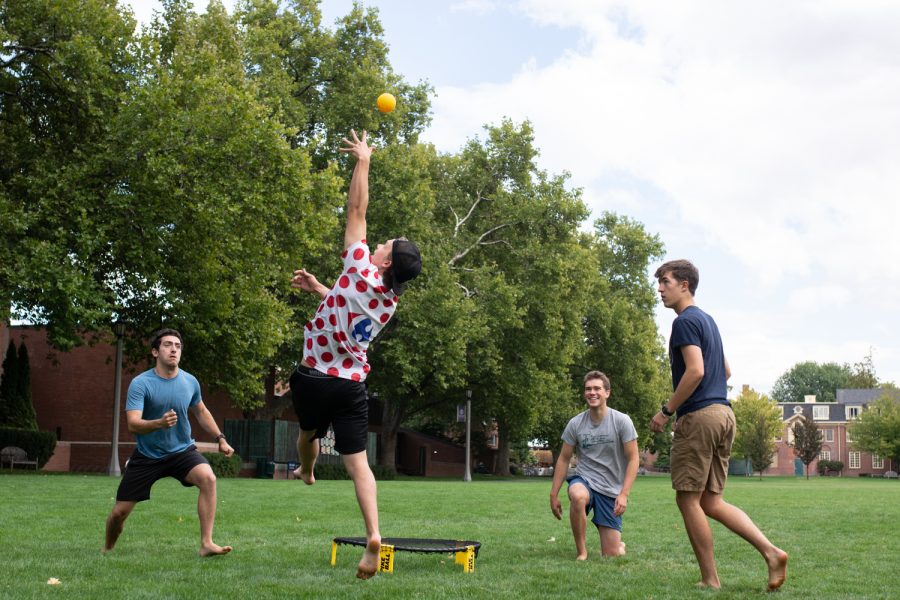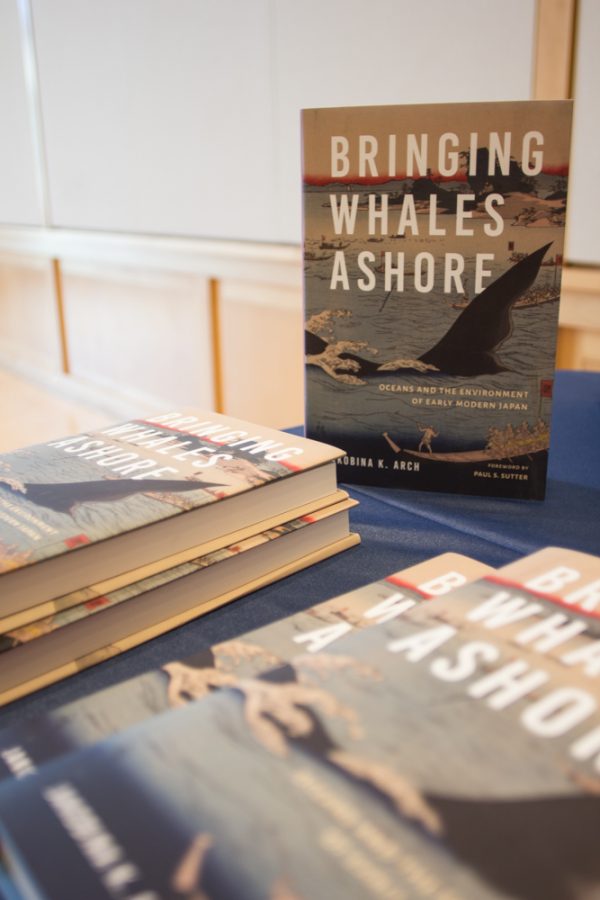6/3 From a surreptitious memo slipped under our room door, Emily and I discovered that we were to meet our host families at 9:30 a.m. on Sunday morning. I was unable to sleep past 5:30 a.m. (really surprising, since I’m usually pretty fond of sleeping in; my body obviously has not yet acclimated to the time difference here), so I lounged around drinking tea and reading until it was time to go down to the dining room and meet our families. I finished The Pillow Book by Sei Shonagon, who was a contemporary of Murasaki Shikibu, author of The Tale of Genji. Sei Shonagon, too, was a courtier and filled The Pillow Book with her observations and opinions on life in the Heian-era imperial court. It was a truly charming read, and my translation included the unforgettable notation, “Only cats of fourth and fifth rank were permitted in the Emperor’s palace.”
Unsure of what to expect, I was pretty nervous before meeting Ai Suzuki, my “host mom.” As it turns out, “host sister” would probably be a more appropriate appellation. Ai-san is totally hip. Decked out in a denim jacket and fedora, she greeted me with a huge hug rather than the customary awkward bow, squealing “Kawaii!” (“You’re so cute!”). Later, while comparing first impressions of our host families, another student exclaimed, “Oh, your host mom is the one who was wearing the heels and cool hat? I wanted her as my host mom!”
As it turns out, Ai-san‘s best friend Kana-san is also hosting a PII student, so we all went out to lunch together. Over udon noodles, we made self-introductions and I got to know Kana-san‘s student, Emmy. She’s a Princeton junior and Japanese major. After lunch, we went to Kanazawa Castle to have a look around. Ai-san explained that her sons were at their father’s house today (she’s divorced) and that I would meet them later. Kana-san‘s children did join us for the festivities at Kanazawa Castle, which were essentially a continuation of yesterday’s huge festival. Kanazawa’s traditional festival activities appear to include a demonstration of ladder-climbing by young children and ceremonial reenactments of dragon-slaying (as far as I could tell, anyway). Today, I found out that all the ladder climbing is in actuality a reenactment of Kanazawa Castle’s first inhabitant’s entry into the palace.



Afterwards, we went to Kana-san‘s house for homemade crepes, which were delicious with whipped cream and fruit. Emmy and I sat and watched a news feature on young women participating in speed-eating contests, which actually really turned me off to food for a while. Something about the extreme close-up shots of dainty Japanese women shoving greasy hamburger after greasy hamburger into their sparkly glossed mouths…blech.
After recovering from watching the speed-eating contests, Ai-san and I ate dinner at the salad bar at the local Big Boy (since her sons, Haru and Rie, would be home late. Ai-san then dropped me off at home, and I took a shower while she went to pick up the boys).

The Japanese don’t take showers the same way Americans do. Rather, the shower is more like the first step leading to the main event: taking a bath. First you rinse your body and hair, usually sitting on a plastic bucket and using a detachable showerhead. Then, after all the soap and shampoo have been rinsed off, you plunge into the deep bath and relax. Since water and electricity are currently very expensive in Japan due to the recent shutdown of the country’s nuclear power plants, PII made sure to let us know not to waste these resources; showers are therefore a pretty short affair.
Ai-san‘s sons, Haru and Rie (or “Ha-chan” and “Re-chan“) are adorable. Ha-chan is very much the baby of the family. At four years old, he will burst into tears over some minor incident (for example, when he can’t find the right building block) and then seconds later go into a fit of giggles when his mom or brother makes a joke. He loves having his picture taken and will jump into dramatic poses and pull his shirt over his head to draw the camera. Re-chan is a little more serious and shy, but with a definite goofy streak. He’s 5 years old and in kindergarten, already learning the kanji (Chinese characters used in Japanese script) that I learned only a few months ago. The siblings resemble little boys worldwide (and not a few grown men) in that they find scatological humor hilarious and love to build cars, streets, and towns out of blocks. I’m really looking forward to getting to know the Suzuki family! Tomorrow I take my speaking and writing proficiency tests, then we’re going to visit Kenrokuen, one of Japan’s most famous and beautiful gardens.

6/4 The first day of school started out a little rough. I woke up at 4:30 a.m., unable to ignore the light streaming through my window (the title “Land of the Rising Sun” seemed more appropriate than ever). I passed the time slowly getting ready for school and reading Into Thin Air by Jon Krakauer, musing that whatever the day had in store for me, it couldn’t be more demanding than climbing Mount Everest. I ate breakfast (cereal, yogurt, and tea) and watched television simultaneously as Re-chan donned his school uniform–white shirt, navy shorts, tall white socks, and a yellow cap. The day before, Ai-san had shown me the way to Nishi Kanazawa Station from her car. It’s about a 10-minute walk from the house to this train station, then a 5-minute bus ride to Kanazawa’s main train station. From there, I walk to the Rifare building where PII students attend classes and meet for extracurricular activities.
I should note here that it’s only a 10-minute walk if you head on the right course. After exiting the house, I promptly set off in the wrong direction and got hopelessly lost. Fraught that I would miss my exam, I desperately asked a woman for directions at what I think was a hardware store. She replied that Nishi Kanazawa was a bit far on foot (I don’t always get lost, but when I do, I get REALLY off track) and asked me to wait while she darted back inside the perhaps-hardware store. Shifting nervously from foot to foot and checking my watch, I felt my heart sink as I realized that the train for the main station left in five minutes. If I was as far away from Nishi Kanazawa as the woman said I was, there was no way I’d make it there in time to catch the train. After a crucial minute and a half, the woman returned with a male co-worker who explained to me again that I probably wouldn’t be able to get to Nishi Kanazawa on foot. I must have looked pretty distressed at that point because he finally said, “It’s okay. I’ll drive you there.”
Now I know this seems pretty sketch, getting into cars with foreign male strangers (Ai-san was horrified when I told her later), but I figured that since the woman had brought him out that it was okay to ride with him to the station. As it turns out, Yamashita-san was very kind and even told me “Nihongo ga jyouzu desu” as we drove to Nishi Kanazawa, a compliment that I scarcely merited after the confusing conversation we’d just had about directions. I thanked him profusely as we pulled up to Nishi Kanazawa station and bowed very, very deeply to him after getting out of the car, but my attempts at humble gratitude were slightly ruined by the fact that my backpack strap had caught on my seat-belt. I bolted up the station’s stairs and managed to hop on the train seconds before it departed. As my blood pressure returned to normal, I realized that already so much of what I had accomplished in Japan would not have been possible without the kindness of strangers. All those people I asked for directions in the train stations on my way to Kanazawa, although they probably didn’t realize it, helped me immensely. Yamashita-san actually went far out of his way to help me, leaving work to drive some lost baka gaijin (foreign idiot) who had somehow forgotten that Nishi Kanazawa station was a near straight-shot from her host family’s home. I guess the moral of the story is that even if it’s annoying or frustrating, or even if it seems as though you’re answering a really obvious question when someone asks you for directions, any help at all means a lot to a person in need.
The PII students congregated in one of the Rifare building’s big classrooms for the program’s opening ceremony, professor introductions, and remaining proficiency exams. Professor Seiichi Makino from Princeton University is the head honcho of the operation (bet you didn’t know that phrase comes from Japanese! Hanchou means “group leader”). The PII group is a really noisy bunch; after we had listened to speeches from Makino-sensei and a representative from IFIE (Ishikawa Foreign International Exchange), the students burst into loud chatter that persisted for about two hours while we waited to take our tests. The writing proficiency test was pretty challenging; we had to write about what we thought was the most important thing in our life while simultaneously demonstrating our kanji knowledge. I wrote about family, the first thing that came to mind, and found myself forgetting how to write even the simplest characters. The speech proficiency test was a lot simpler, though nevertheless nerve-wracking. One of the third-year professors interviewed me, asking about my hometown, college, and host family, and I answered as best I could, trying to create complex sentences while maintaining comprehensibility.
After everyone had finished their exams, we took a break for lunch. I bought a salad, jello, and tea from a konbini (convenience store) close to Rifare and clustered with the other PII students, chatting in English and Japanese. We returned to Rifare at 1:00 to board the bus to Kenrokuen.
Kenrokuen is spectacular. It’s so beautiful that it nearly eludes description, so I’m including lots of pictures in this post. We toured the garden and participated in a chanoyu (tea ceremony) demonstration that was in actuality less of a demonstration and more of a snack break, as the ceremony practitioners served all of us tea and sweets. It was really hard not to feel superior in this situation, as I am pretty sure I’m the only person in the program who has studied chanoyu and knows how to conduct myself properly during this kind of activity. In hindsight, I guess it really doesn’t matter whether you sit properly or make the appropriate slurping sound while draining your tea bowl as long as you respect the tea room and enjoy yourself.





We returned to Rifare around 4:00 and I hung out in the T.V. lounge for an hour, mostly blogging. Rifare is currently the only wi-fi hotspot available to me, so I apologize for the backup in my posts!
I met up with Ai-san at her workplace, the Kanazawa Forus shopping center. She works at Duffer, a shop specializing in casual clothing an featuring one particularly hunky Australian-looking model almost exclusively in its advertisements.
Ai-san told me in the car on the way home that as soon as I had left that morning, Ha-chan had asked her where I went and whether I would be back soon to play! That made my heart melt. We had a “sushi party” style dinner, wrapping various vegetables with rice in seaweed. I astonished Ai-san by consuming natto with gusto. Natto is a fermented soybean dish with a slimy, mucus-like texture and odd smell, particularly abhorrent to foreigners. It’s not bad, actually, but I understand why people would find it kind of hard to stomach.


Tomorrow we’re visiting the Ishikawa-ken Prefectural Government Office, an excursion that will almost certainly be boring. During my last visit to Japan with the Santa Rosa Kagoshima Student Exchange Program, our group had to perform a similar duty. The Prefectural Government Office has given PII a pretty generous donation, however, so a visit to express our thanks is inevitable. I am almost certain that the visit will consist of listening to speeches and receiving packets of information about Kanazawa and Ishikawa-ken that contain minutiae such as how much rain the prefecture receives annually…but, who knows, maybe Ishikawa will surprise me!





Larry Beaulaurier • Jun 9, 2012 at 6:56 am
Nicely done! I look forward to future posts….